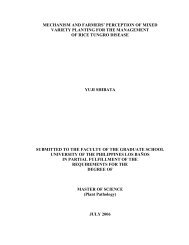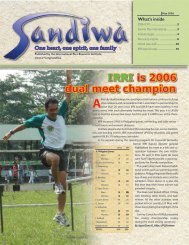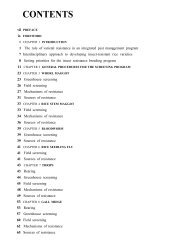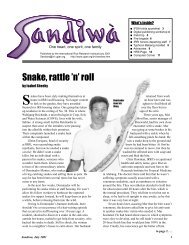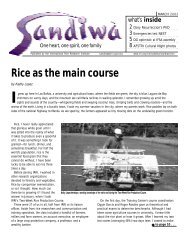Untitled - International Rice Research Institute
Untitled - International Rice Research Institute
Untitled - International Rice Research Institute
Create successful ePaper yourself
Turn your PDF publications into a flip-book with our unique Google optimized e-Paper software.
The missing link<br />
Epidemiology<br />
There is little doubt that many pathogens are<br />
seedborne. Questions arise, however, on whether the<br />
introduction of seedborne inoculum of these pathogens<br />
would lead to the establishment of a disease in<br />
the field or whether the field population of a fungal<br />
pathogen is derived from the seedborne inoculum.<br />
Pathogens of significance to quarantine suggest<br />
the potential of seed transmission. They also relate to<br />
the potential damage or yield loss caused by diseases<br />
derived from the seedborne inoculum of the pathogen.<br />
However, there is very little accurate information<br />
about yield loss caused by rice diseases, and<br />
diseases derived from seedborne inoculum. Yield<br />
loss caused by a pest outbreak or a disease epidemic<br />
is important in determining pathogens with quarantine<br />
significance. There are very few comprehensive<br />
studies or databases on yield losses caused by pests<br />
or pathogens in scientific literature. Studies conducted<br />
and documented by Savary et al (1996, 1997,<br />
1998, 2000a,b), Savary and Willocquet (1999), and<br />
Willocquet et al (1999a,b) are some of the most comprehensive<br />
ones on rice diseases. Using both survey<br />
and experimental data, they developed pest and<br />
pathogen profiles for different rice production situations<br />
(PS). Production situations refer to the set of<br />
environmental conditions—climatic, technical, social,<br />
economic, and biological—under which agricultural<br />
production takes place. These were then related<br />
to yield losses with individual pests and pathogens,<br />
and also pest and pathogen profiles.<br />
Savary et al (1996, 1997, 1998, 1999) believe<br />
that by using such a systems approach combined<br />
with different statistical analyses, all these factors<br />
could be captured by a limited number of variables,<br />
such as those that describe patterns of cropping practices,<br />
for example, method of crop establishment,<br />
amount of chemical fertilizer used, type of weed<br />
control, and rice cultivar type (with or without disease<br />
resistance). In reality, farmers’ practices are, to a<br />
large extent, reflections of, or adaptations to, social,<br />
physical, and biological environments. Injury profiles<br />
refer to the sequence of harmful organisms that may<br />
occur during the crop cycle. Many such organisms<br />
affect rice. The number of processes by which a pest<br />
or pathogen may affect rice, however, is limited to<br />
less than 10, and injuries are often associated with<br />
one another. On this basis, yield losses caused by<br />
individual injuries as well as by injury profiles establish<br />
the importance of rice pests and diseases in specific<br />
PS at the regional level (Savary et al 2000a,b).<br />
The database identified sheath blight caused by<br />
Rhizoctonia solani AG1 and brown spot caused by<br />
Bipolaris oryzae as the two most important diseases<br />
in rice in Asia, each responsible for 6% yield loss,<br />
whereas blast caused by Pyricularia grisea and bacterial<br />
blight caused by Xanthomonas oryzae pv.<br />
oryzae account for 1–3% and 0.1% yield losses, respectively.<br />
However, most rice cultivars planted by<br />
Asian farmers are resistant to these two diseases. If<br />
cultivars possess no resistance to these two diseases,<br />
yield losses are likely to be higher than current estimates.<br />
Other diseases, such as sheath rot, stem rot,<br />
and those known as sheath rot complex and grain<br />
discoloration (Cottyn et al 1996a,b), are responsible<br />
for rice yield losses ranging from 0.1% to 0.5%. All<br />
other diseases alone or in combination would not<br />
cause more than 0.5–1% yield losses based on estimates.<br />
Projected yield losses cause by various rice<br />
diseases under different production situations are<br />
given in Table 3.<br />
In seed health testing, detection frequency<br />
means the number of pathogens detected in a seed<br />
lot. Infection frequency refers to the number of seeds<br />
(based on 400 seeds tested) within a seed lot which<br />
are infected (Mew and Merca 1992) and is equivalent<br />
to the inoculum level. In the epidemiological<br />
sense, no information is available to correlate detection<br />
frequency and infection frequency to seed transmission<br />
and disease establishment in the field. Still,<br />
there are other questions related to seedborne pathogens<br />
that must be answered. In rice, in which most<br />
fungal pathogens can be seedborne, and for which<br />
current farmer cultural practices have done little to<br />
improve quality (a result of farm labor shortage and<br />
short turnaround time), what is introduced to the field<br />
with seeds when the rice crop is planted? In seed<br />
production fields, it is necessary to practice disease<br />
management to produce disease-free seed?<br />
6



